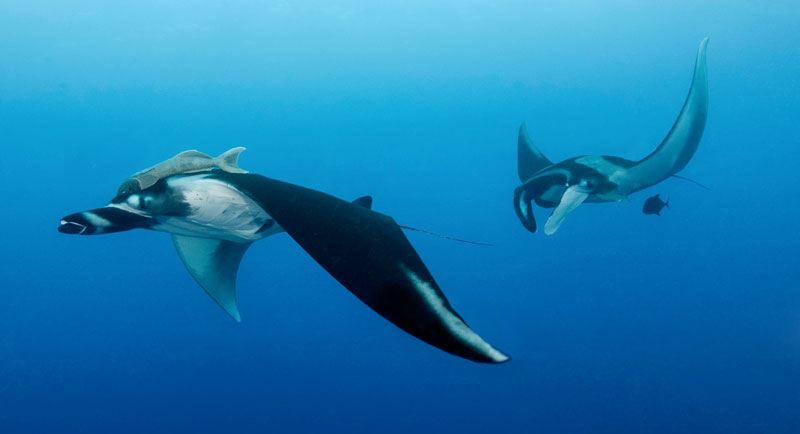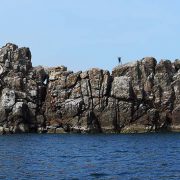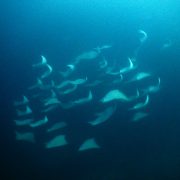Similan Diving Conditions 2017-18
An appraisal of diving conditions within the Similan Islands National Park in January 2018, nearing the halfway point of the 2017-2018 Similan diving season, based on observations and logged dives conducted from the Similan liveaboard MV Hallelujah.
Similan Weather Conditions
Weather patterns from October 2017 through to January 2018 were comparable with the same dates one year ago though not quite as severe. November should see the weather settle into calm conditions marking the start of the North West Monsoon, but the last few years have seen a delayed shift in the changing of the seasons. Frequent days with high winds and sporadic storms occurred from the start of the season well into January.

Heavy rain on the mainland, in Khao Lak….

…meanwhile, blue skies & fluffy clouds in the Similan Islands
A few days into the new year, a larger weather depression over the South China Sea had a knock on effect with the climate in our local area, with an increase in wind and rain squalls over the Andaman Sea. These conditions were more pronounced on the mainland. It is always worth noting that if you are staying in a nearby town such as Khao Lak and it is raining heavily there, it may not be raining in the Similan Islands. Clouds often form on the coast as the cool air rises up the mountains. Please contact us if you would like to find out the most recent diving conditions during your stay in Thailand.
By mid January the weather appears to finally have settled into it high season splendour with blue skies over the Similan Islands, a mild breeze blowing from the north and calm sea conditions. Despite stormy days visibility underwater by January has increased to around 30m underwater.
Similan Diving Conditions
Our documented improvement of coral life on many Similan dive sites has continued during the first half of our diving season with more new species of corals repopulating areas formerly damaged by coral bleaching in 2010. It has been a slow but steady improvement in Similan diving conditions over the past 8 years.

Sea fan at Koh Tachai, Similan National Park
There are areas of new staghorn corals at Hideaway Bay occurring both in shallow and deeper areas. Staghorn has been slow to reappear around the Similans since 2010 but this fast growing coral appears to be rapidly reestablishing itself with healthy colonies.
Breakfast Bend, possibly one of the hardest hit reefs in 2010 is finally showing positive signs of recovery. Lobe corals a repopulating former areas of their deceased relatives. New table corals are flourishing which is nice to see. Like staghorn coral, once a table coral has a strong base it will expand quickly.
New Warty bush coral colonies continue to increase, especially in the shallow areas on top of the huge granite boulders at West of Eden. Unfortunately, with the new growth of corals there is also tell tale damage caused by divers in these areas with snapped pieces of coral littering the sea bed. If rescued in time, Warty bush coral will continue to grow if replanted firmly somewhere where the current will flow over it.
Similan Diving Marine Life
With new coral colonies forming around many Similan dive sites we would expect to see an increase in fish species that inhabit these coral structures. This is definitely the case as we witness a significant increase in small colourful reef fish, especially damsel fish, blennies and basslets.

There is also good productivity in the waters around the Similan Islands. Increased numbers of fusiliers and glassfish provide food for growing populations of Bluefin trevally, Giant trevally, Dogtooth tuna, Longnose emperor fish and various types of snapper. Nowhere is this more apparent than at Richelieu Rock where diving conditions easily surpass previous years for high productivity and action packed dives.
Sadly an increase of smaller predatory fish continues to highlight the absence of our true apex predators. Shark sightings remain rare and very sporadic which does not bode well for the long term balance of our underwater ecosystems. This may have a dramatic effect on SImilan diving conditions in the years to come.
More Great Similan Diving to Come
With the continued recovery of coral life throughout the Similan Islands and the ever increasing productivity around the dive sites there is a positive outlook for the remainder of the 2017-2018 Similan diving season. Especially as we are now into Giant Manta ray season.

There have already been numerous Manta encounters at Koh Bon and Koh Tachai. Surprisingly even a Reef Manta encounter. Sightings have yet to match numbers recorded through 2015-2016 but there is plenty of time and many dives before our season ends at the end of April. All at Diversion have high hopes for Manta encounters on our upcoming Off the Chart Expedition to Myanmar departing 10th March 2018.
Incidentally, Whale shark encounters approximately match the numbers seen during the last year’s season. Hopefully, as Manta encounters increase, so will our Whale shark encounters.
I am currently out on a Similan Liveaboard right now, enjoying calm seas and exception weather conditions and, as always enjoying great diving conditions in the Andaman Sea.














